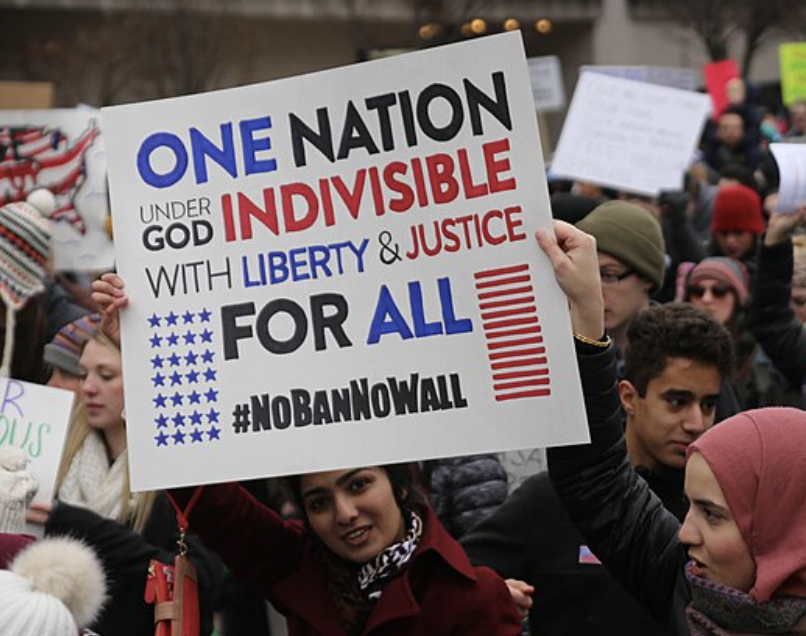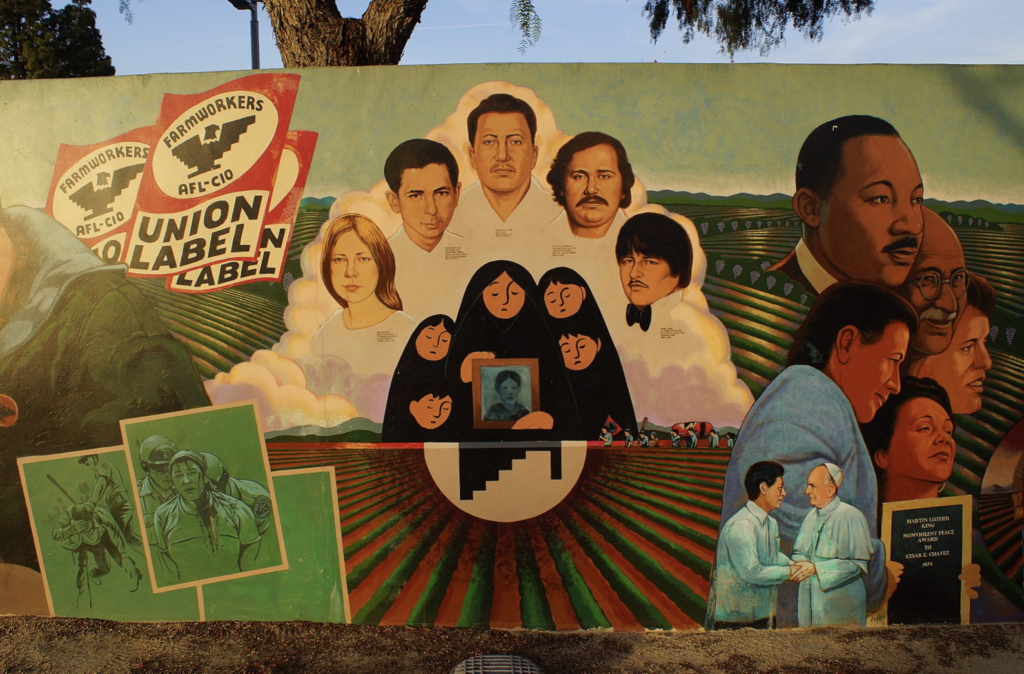Shaping a Unique Identity: Muslim and Arab American

Woman holding sign Photo Credits: Paul Sableman
Percentage of Muslim Arab American
With the Arab American Muslim community viewed as separate from Americans and a singular group, it is safe to say that there is ignorance driving the misconception of this community. Furthermore, “Based on various reports, 65-70% of Arab Americans are Christian… 30-35% of Arab Americans are Muslims.” (Arab America). Regardless of the popular misconception that all Arabs are muslim most Arabs are not muslims. For example, “Most Arabs in America are not Muslim, and most Muslims are not Arabs.” (Telhami). To add on, there are 6 million American Muslims and not all are Arab. With the distinction between these two group identities that have an overlap, it is critical to investigate what led up to this misconception.
9/11
With the terrorists of 9/11 being Arab and using their muslim ideology as a reason for the attack, many Arab and muslim organizations naturally released statements. “Major Arab and Muslim organizations issued statements strongly condemning the attacks, refusing to allow their typical frustrations with issues of American policy in the Middle East to become linked to their rejection of the terror.” (Telhami). Following the tragedy Arab and Muslim leaders appropriately condemned the terror attack that tied the Islam and the Arab identity to anti-American sentiments.
However, the connection was cemented and paranoid plans were implemented to ensure no further attacks are carried out. For instance, “About $1.1 billion of that has been spent on preventing terrorism at home. Counterrorism efforts in the U.S. have taken various forms since then: new government agencies, surveillance programs and the loosening of longstanding law enforcement guidelines” (Khan and Ramachandran). Interestingly enough regardless of the American portion of the identity of Arabs and Muslims, there was enough distrust of the loyalty of both groups to America. These preventative measures are in place to protect the Americans from the Arab and Muslim Americans that in the eyes of America might turn their backs and join the extreme side.
Bodega Strike
As years go back these measures become more restrictive and paranoid. In addition, “As many as 5,000 business owners and their supporters gathered in Brooklyn for a protest against President Trump’s immigration ban. In a strike organized by Yemeni-American business owners, approximately 1,000 bodegas and other businesses shuttered on Thursday in protest of President Trump’s controversial executive order on immigration…” (Chandler). Undoubtedly, the frustration of the counter-terrorism measure within Trumps immigration ban touched a nerve. It disregarded the need of Arab muslims and other Arabs to connect with their families overseas.
In some cases it was Arab Americans that were robbed from their right to travel and in others it was foreign Arabs with green cards who were trapped. This ban also combines the misconception of all Arabs as muslims, Arabs and muslims Americans not being loyal to America, and therefore their rights are put to the side for national security. Both situation touched a nerve in the community, as free movement was a freedom many enjoyed practicing for generations.
History of Yemeni Immigration
Yemeni immigrants have a historical connection to America.Additionally, “Yemen migration in America is unique because early migration waves were made up of mostly adult males of working age. The earliest recorded history of Yemenis coming to America was in 1890. Others were naturalized after serving in WWI and WWII.” (Yemeni American Merchants Association). Yemeni Americans have been serving America through their physical labor and war involvement starting in 1890 and ever since.
With this long historical connection issues were bound to occur. Specifically, “These jobs often consisted of hard physical labor for little pay and benefits. Because of this language barrier, they were ignorant of their rights as workers.” (Yemeni American Merchants Association). The issues lied within fairness of the labor offered and available to the Yemeni immigrants. Similarly to the Bodega Strike there were unions forming with the support of Yemenis fighting for appreciation of the work of minority laborers and their rights.

Mural for Historical Figures Photo Credits: Chris English
Nagi Daifullah
Nagi Daifullah, “…had already been working with the United Farm Workers and was hired as an organizer at this point, it was during this tense summer that he took on a greater role as a picket captain… Authorities attempted to smear Nagi’s name (Sep 21st, 1973, No.18) and his memory in the aftermath of his murder.” (Mansour). Daifullah is a notable Yemeni American historical figure and an inspiration to all who fight for labor unions, regardless of their religion or ethnicity. Without a doubt the injustice that Daifullah faced only served as fuel for the Arab American community to unite and for American unions to carry on fighting for their labor rights.
It should be noted that, “During Nagi’s funeral march in August of 1973, Yemenis decided to carry a portrait of the late Egyptian President Gamal Abdel Nasser, a leader of anti-colonial Arab nationalism, an ideology brought by Yemenis to the California fields.” (Mansour). Daifullah’s lasting influence inspired his fellow Arab American union workers to unite and celebrate their roots. Instead of letting the abuse go on Arab Americans like Daifullah stood up for their rights. Even when faced with the death of a valued member Arab American’s refused to slow down and allow their purpose in America to deteriorate.
Invisible Paper Trails
Arab Americans have been victimized by fellow Americans who sought to take advantage of and mistreat them and their rights, rather than accept them into society.”Moments like these serve as a reminder to Muslims that our belonging in the United States is not secure but conditional: At the slightest sign of political disagreement, some Americans are eager to deny or revoke our citizenship.” (Lalami). Even when faced with the death of Daifullah, Muslim and Arab American’s refused to slow down and allow their purpose in America to deteriorate. Similarly, the response to 9/11 and the Travel Ban once again demonstrated the strong will and voice of Arab and Muslim American. Arab Muslim Americans have left impressive paper trails that are invisible to those that take the community for granted. However, when the oppression becomes unbearable those trails lit aflame within a heartbeat by hardworking Arab Muslim Americans.
Works Cited
Chandler, Adam. “The Yemeni Bodega Strike.” The Atlantic, Atlantic Media Company, 25 Apr. 2017, www.theatlantic.com/business/archive/2017/02/yemen-bodega-brooklyn-immigration-ban/515670/.
Khan, Saher, and Vignesh Ramachandran. “Post-9/11 Surveillance Has Left a Generation of Muslim Americans in a Shadow of Distrust and Fear.” PBS, Public Broadcasting Service, 16 Sept. 2021, www.pbs.org/newshour/nation/post-9-11-surveillance-has-left-a-generation-of-muslim-americans-in-a-shadow-of-distrust-and-fear.
Maloney, Suzanne. “Arab and Muslim America: A Snapshot.” Brookings, 28 July 2016, www.brookings.edu/articles/arab-and-muslim-america-a-snapshot/.
Mansour, Omar. “Nagi Mohsin Daifullah and the Yemeni Farm Workers of California.” Arab America, 20 May 2021, www.arabamerica.com/nagi-mohsin-daifullah-and-the-forgotten-yemeni-farmworkers-of-california/.
“Module III: Arab Americans and Religion – Center Unified School District.” MODULE III: ARAB AMERICANS AND RELIGION, www.centerusd.org/documents/Departments/SAFE%20Office/Arab%20Americans%20and%20Religion/Arab-Americans-and-Religion.pdf. Accessed 25 Sept. 2023.
“Yemeni American Merchants Association.” YAMA, www.yamausa.org/yemen-history/. Accessed 24 Sept. 2023.









